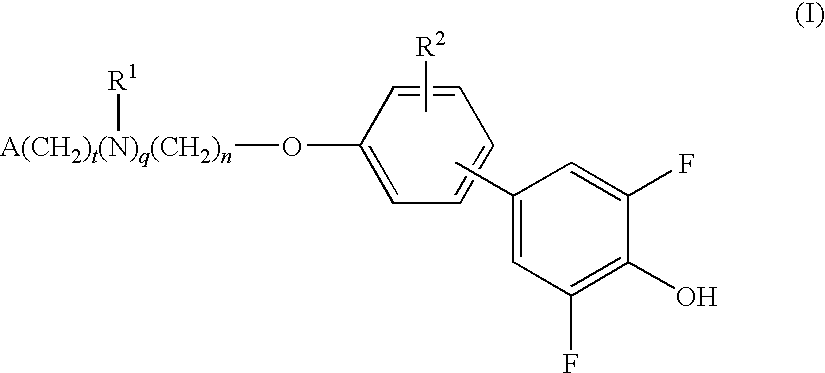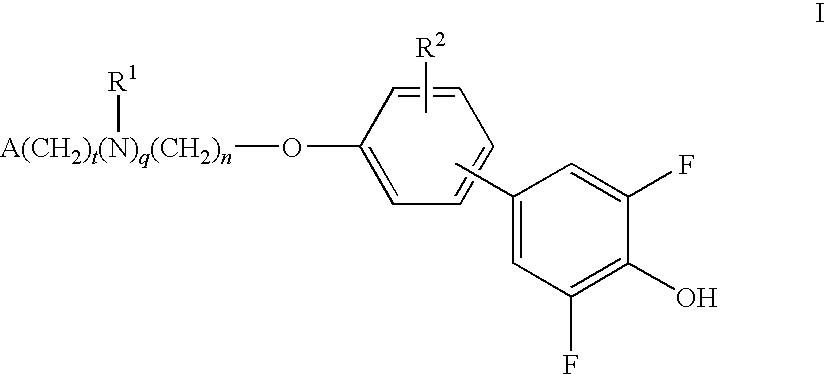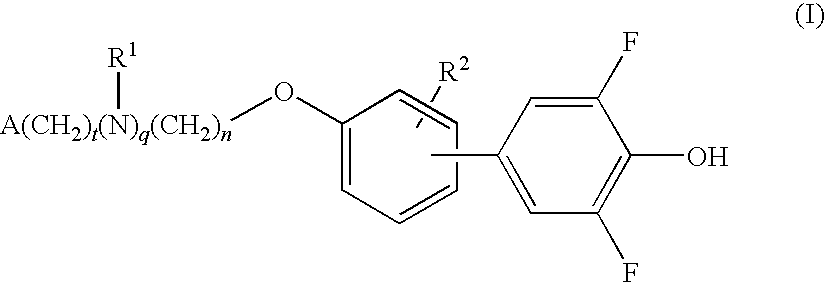Compounds for the treatment of metabolic disorders
a metabolic disorder and compound technology, applied in the field of metabolic disorders, can solve the problems of diabetes mellitus, major morbidity and mortality, debilitating complications, and vulnerability to coronary arteries
- Summary
- Abstract
- Description
- Claims
- Application Information
AI Technical Summary
Benefits of technology
Problems solved by technology
Method used
Image
Examples
example a
Improvement of Metabolic Abnormalities in Insulin-Dependent Diabetes
[0085]Streptozotocin (STZ) is a toxin that selectively destroys insulin-producing pancreatic beta cells, and is widely used to induce insulin-dependent diabetes in experimental animals.
[0086]Female Balb / C mice (8 weeks old; 18-20 grams body weight) are treated with streptozotocin (STZ) (50 mg / kg i.p. on each of five consecutive days). Fourteen days after the last dose of STZ, blood glucose is measured to verify that the animals are diabetic, and the mice are divided into two groups of 5 animals each, one group receiving a compound of the invention (250 mg / kg) daily by oral gavage, and the other receiving vehicle (0.75% hydroxypropylmethylcellulose, a suspending agent, in water). A group of nondiabetic mice from the same cohort that did not receive STZ is also monitored. Blood samples are taken periodically for determination of blood glucose concentrations, and body weights are also recorded.
[0087]After several weeks...
example b
Improved Survival of Mice with Lethal Insulin-Dependent Diabetes
[0088]Female Balb / C mice (14 weeks old) are treated with a single dose of streptozotocin (175 mg / kg i.p.) to induce severe insulin-dependent diabetes. Seven days later, mice are divided into three treatment groups: A compound of the invention, pioglitazone, and vehicle. Mice are treated daily via oral gavage, and survival is monitored over time.
example c
Reduction of Mortality in Severe Insulin-Dependent Diabetes
[0089]Female balb / C mice (19 wks of age at start of experiment) are challenged with multiple high doses of STZ (75 mg / kg i.p. on 5 consecutive days). Animals are then divided in two groups (20 mice / group) matched for severity of diabetes. Four days after the last dose of STZ, treatments are initiated. One group receives Vehicle (0.4 ml of 0.75% HPMC, p.o.), and the other group receives a compound of the invention orally (30 mg / kg / day). After three weeks of daily treatment, cumulative mortality in the two groups is recorded.
PUM
| Property | Measurement | Unit |
|---|---|---|
| temperatures | aaaaa | aaaaa |
| weight | aaaaa | aaaaa |
| body weight | aaaaa | aaaaa |
Abstract
Description
Claims
Application Information
 Login to View More
Login to View More - R&D
- Intellectual Property
- Life Sciences
- Materials
- Tech Scout
- Unparalleled Data Quality
- Higher Quality Content
- 60% Fewer Hallucinations
Browse by: Latest US Patents, China's latest patents, Technical Efficacy Thesaurus, Application Domain, Technology Topic, Popular Technical Reports.
© 2025 PatSnap. All rights reserved.Legal|Privacy policy|Modern Slavery Act Transparency Statement|Sitemap|About US| Contact US: help@patsnap.com



